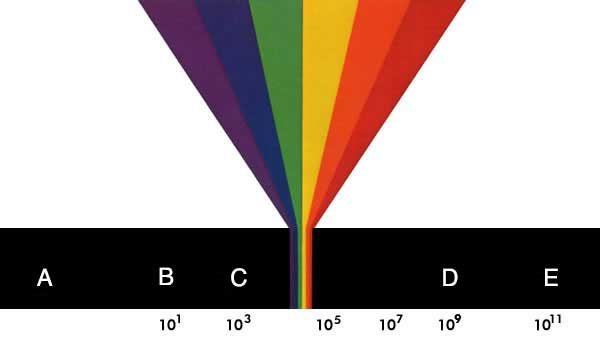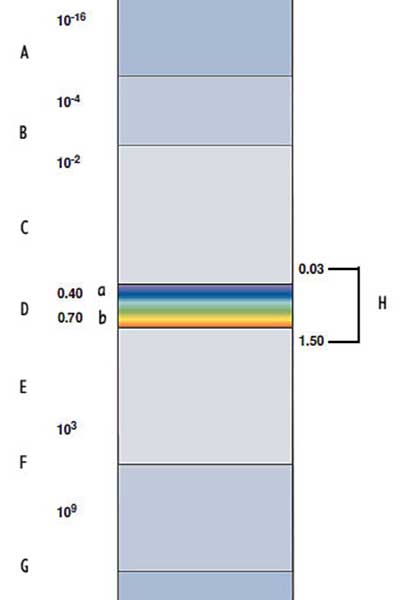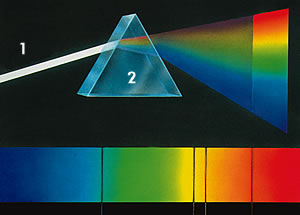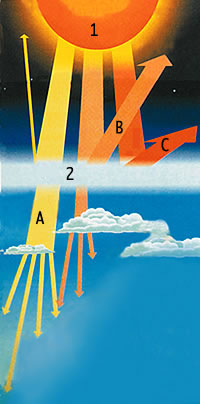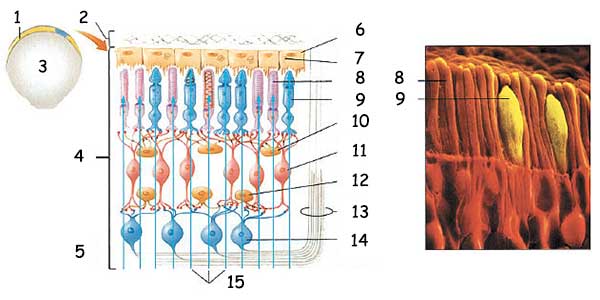Bigotry: The Dark Danger
Allah's Artistry In Colour

DOWNLOAD THE BOOK
CHAPTERS OF THE BOOK
< <
3 / total: 7
Design in ColoursColour is a concept that helps us to identify the properties of objects and define them more precisely. Thinking about the colours of the objects around us, we simply come to notice what a variety of detailed colours we are surrounded by. Everything, animate or inanimate, has a colour. Living creatures of the same species have the same particular colours everywhere in the world. No matter where you go, the colour of the flesh of the water-melon is always red, kiwis are always green, seas are always shades of blue and green, snow is white, lemons are yellow, the colour of elephants is the same in any part of the world as also the colours of trees. They never change. This goes for artificially produced colours as well. Wherever you go on the earth, if you mix red with yellow, you will get orange or if you mix black and white you will get grey. The result is always the same. At this point, it may be useful to think somewhat differently. First, let us think by asking the question of how the colours of objects are made. We can explain this by an example. Imagine that you walk into a store and see fabric of different designs and models, the colours of which are extremely harmonious with each other. Surely, those fabrics did not come there by chance; conscious people drafted their designs, determined their colours, subjected them to a number of dying processes, and after putting them through many other intermediate stages, they displayed them in that store. In short, the existence of these fabrics depends on the people who designed and manufactured them. When you see them, you do not say that they came there by chance, or that their designs were formed by coincidence as a result of paints spilt over the fabrics. In fact, no man of reason would make such a claim. Allah, there is no god but Him, the Living, the Self-Sustaining. He is not subject to drowsiness or sleep. Everything in the heavens and the earth belongs to Him. Indeed, there is a conscious Will that presents us the views we see in nature all the time, the butterflies, flowers, multi-coloured places under the sea, trees, and clouds etc., just in the way these fabrics are presented to us. The diversity in the universe is the consequence of a special design. This design is manifested in every stage from the formation of light to its becoming a colourful image in our brain. This is one of the greatest evidences of the existence of an Owner, that is, a Designer of the design in colours. Surely, Allah, Who possesses an infinitely superior wisdom and power of creation, creates all the colours and designs in the universe that man admires. The stages of colour formation were briefly listed earlier. In this chapter, the superior design evident in colour will be examined under separate headings in accordance with the progression from light to eye and brain.
1- Light, Life and ColourThe sun is only one of the billions of medium size stars in the universe. What makes the sun the most important star of the universe for us is its size, its relationship to the planets moving around it and the particular rays it emits. If just one of these characteristics of the sun were different from current values, there would be no life on earth. Indeed, the sun has the ideal values for life to originate and be maintained on earth.3 This is why scientists describe the sun as the "source of life" on earth. Sunlight is the only source of heat, heating the earth in the most appropriate way, and light, helping plants with their photosynthesis. It is well known that heat and photosynthesis are essential for life. In addition, the existence of daylight and a colourful world depend on the rays emitted from the sun. In this case, the question of how these rays, the ultimate energy source for the earth, come into existence comes to mind. Surely, that these rays, which are the key to life on earth, serve such important purposes and, at the same time, have all the necessary characteristics for this, cannot be attributed to coincidence. The reason for this will be better understood when the structure of light is examined.
The energy emitted by the stars moves in waves through the void of space. Similarly, both light and heat are emitted by the sun, which is a star, as energy in the form of waves. The movement of this energy the stars emit can be compared to that of the waves caused by a stone thrown into a lake. Just as the waves in the lake have different lengths, so do heat and light have different wavelengths as they diffuse.
At this point, it would be useful to give some information about the different wavelengths of light in the universe. The stars and other light sources in the universe do not emit the same kinds of light. These different rays are classified according to their wavelengths and frequencies. These different wavelengths are spread over vast areas. For example, the shortest wavelength is 1025 1025 times smaller than the longest wavelength (1025 is a very big number consisting of number 1 followed by 25 zeros)4
In the whole spectrum, the total rays emitted by the sun are squeezed into a very short interval. 70% of the different wavelengths the sun emits lie within a narrow interval ranging from 0.3 micron to 1.50 micron. (A micron is 10-6m) Examining why sunrays are restricted to such a narrow interval, we come to an interesting conclusion: the rays that make life, and colour, possible on earth are only those present in this interval. British physicist Ian Campbell, who defines this superior design as "incredibly astonishing" in his book "The Energy and the Atmosphere", draws attention to this point:
The greater part of this small range of radiation emitted by the sun from the electromagnetic spectrum, a spectrum having a width where the longest wavelength is 1025 times large than the shortest, is named "visible light". The rays that lie below and above this interval, on the other hand, reach the earth as infrared and ultraviolet rays. Let us now briefly examine the properties of these two kinds of rays. Infrared rays reach the earth in the form of heat waves. Ultraviolet rays that contain higher energy, on the other hand, may have a damaging effect on living beings. Infrared rays pass through the atmosphere, and provide heat, which makes the earth a place suitable for life. Ultraviolet rays, on the other hand, can reach the earth only at a certain rate. If this rate were a little higher than its current level, it would harm the tissues of living beings and cause mass deaths, while if it were a little lower, then the energy needed for living beings would not be provided. These points are details crucial for life. As understood from the functions and uses of the rays emitted by the sun, there is order and control in every existing system in the world. Surely, it is impossible for such a system, the delicate balances of which we briefly dwelled upon, to have been formed by coincidence. Examining another element of this flawless system, we once again see the impossibility of its coming into existence as a consequence of coincidence. 2- The shield protecting the earth: The Atmosphere
In previous pages, we mentioned that some of the sunrays are harmful for life on earth. In order to avert this harmful effect, a solution is needed. Let us put our heads together and find a solution to this problem by developing an efficient system to filter sunrays. We should also take cognisance of the fact that this system should be a multifunctional one, which will protect the world from the harmful effects of the sun, ensuring that this is maintained permanently, not requiring maintenance, and also capable of preventing some other possible threats to the earth. Certainly, in such a situation, several alternative solutions will surface. Yet, nothing put forward will be as efficient and versatile as the present filter that now covers the earth: the atmosphere. The atmosphere of the earth is one hundred percent successful at filtering harmful rays and Allah specially designed it in order to protect the world. By means of specific layers of the atmosphere, sunrays reach earth only in required amounts because the atmosphere processes the sunrays specifically according to their wavelengths. Our atmosphere is like a giant refining plant designed for filtering these rays. This gigantic refining system that has no equal on the earth has been carrying out these processes because of its special design. Allah draws attention to the creation of the skies as follows, (the Arabic word for 'heaven – sama' is also the word for 'sky'): The creation of the heavens and earth is far greater than the creation of mankind. But most of mankind do not know it. (Surah Ghafir: 57) The rays coming from the sun are quite specific. It is necessary for them to possess properties enabling them to pass through the atmosphere and reach the earth. Similarly, the atmosphere, too, has to have a special structure to allow these rays to pass through. Otherwise, neither the existence of the atmosphere nor the structural appropriateness of the rays will be of any use. Because of the ray-permeable nature of the atmosphere, the rays coming from the sun easily reach the earth.
There is another important point that needs mention. Whilst letting only visible light and the near infrared rays required for life pass through, the atmosphere prevents all other destructive rays from reaching earth. The atmosphere of the earth serves as a very important "filter" for the destructive rays coming from the sun or from non-sun sources, that is, from other zones in space.6 Michael Denton, a renowned astronomer, states this as follows:
It is apparent that there is a highly developed design in the structure of the atmosphere. Out of a spectrum whose width is hinted at by this figure of 1025, the sun emits only those rays that are useful to us and necessary for a colourful world, and the atmosphere mainly allows harmless and indeed useful rays to reach the earth. In addition, due to the properties of the gases present in the atmosphere, the eyes of living beings, which are directly exposed to sunlight, are protected against any harmful effects. All these are evidence that Allah has created everything in due proportion. He to Whom the kingdom of the heavens and the earth belongs. He does not have a son and He has no partner in the Kingdom. He created everything and determined it most exactly. (Surat al-Furqan: 2)
3- Light Striking MatterLight coming from the sun reaches the earth at a speed of 300,000 km per second. Owing to the speed of light, we always see a world full of colour. How, then, is this uninterrupted image made? Passing through the atmosphere at enormous speed, light reaches the earth and strikes objects. When light strikes an object at this speed, it interacts with the atoms of the object and reflects at different wavelengths corresponding to different colours. In this way, the book you are now holding, its lines, pictures, the view you see when you look outside, trees, buildings, cars, the sky, birds, cats, in short everything your eyes see, reflect their colours. The molecules enabling these colours to be reflected are pigment molecules. That is, the colour reflected by an object depends on the pigment molecules present in that object. Every pigment molecule has different atomic structures. The atomic numbers as well as the types and the sequences of atoms in these molecules are different. Light hitting such diverse pigments is reflected in different shades of colour. However, this is not enough for the formation of colour. For reflected light possessing a certain colour quality to be perceived and seen, it has to reach a visual apparatus capable of perceiving it.
4- Light Coming to the EyeFor rays reflected by objects to be perceived as colour, it is necessary for them to reach the eye. The existence of the eye alone is not sufficient. After reaching the eye, the rays ought to be converted into nerve signals that reach a brain working in harmony with the eyes. Let us think about our own eyes and brains as the closest example. The human eye is a very complex structure that consists of many different organelles and parts. As a result of the simultaneous and harmonious operation of all these parts, we see and perceive colours. The eye, with its tissues and organelles such as lachrymal glands, cornea, conjunctiva, iris and pupil, lens, retina, choroid, eye muscles and lids, is a matchless system. In addition, with its extraordinary nerve web that establishes its connection to the brain, and extremely complex vision area, the eye, as a whole, has a very special structure, the existence of which cannot be attributed to coincidence.
After a short introduction to the eye, let us also look at how the event of seeing takes place. Light rays coming to the eye first pass through the cornea, then the pupil and lens, and finally reach the retina. The perception of colour begins at the cone cells in the retina. There are three main cone cell groups that strongly react to certain colours of light. These are classified as blue, green and red cone cells. The colours red, blue and green, to which cone cells react, are the three primary colours existing in nature. With the stimulation of cone cells, which are sensitive to these three colours, at different degrees, millions of different colours appear. The cone cells convert this information pertaining to colour into nerve impulses through the pigments they contain.8 Next, nerve cells connected to these cone cells transmit these nerve impulses to a specific area in the brain. The place where the multi-coloured world that we view throughout our lives is formed is this area in the brain measuring a few centimetre squares. 5- A Colourful World in Our Dark BrainThe final stage in the formation of colour takes place in the brain. As mentioned in the previous chapter, nerve cells in the eye convey the images converted into nerve impulses to the brain and everything we see in the outer world is perceived in the vision centre of the brain. At this point, we are confronted with an amazing fact: the brain is a piece of meat that is completely dark inside. Nerve impulses coming from images created on the retina by objects are deciphered in the brain, which is completely dark inside. Images of the objects, with their colours and all other properties, are formed as perceptions in this visual centre. How does this process of perception take place in such a piece of soft meat? A lot of question marks remain as to how colours are perceived. Chromatists are still unable to answer those questions such as how nerve impulses are transmitted to the brain via optic nerves and what kind of physiological effects this creates in the brain.9 All they know is that the perception of colours as realities takes place within us, that is, in the centre of vision in our brain.10 (For detailed information, see the chapter The Secret Beyond Matter)
In fact, most of the processes carried out by the brain have not yet been elucidated. The explanations of the subject are largely based on theories. However, the brain has been fulfilling all its functions perfectly since the moment man came into existence, just as it does today. People's experiencing a three dimensional world, along with all its colours, designs, sounds, smells and tastes, in a piece of meat weighing nearly one kilogram is made possible only by the perfect creation of Allah. Everyone finds this matchless miracle of creation ready at birth. Man has no control whatsoever, neither in the formation of its functions, nor in their continuity, nor at any other stage. Kuran’da Rabbimiz şöyle buyurmaktadır: De ki: "Siz, Allah'ın dışında taptığınız ortaklarınızı gördünüz mü? Bana haber verin; yerden neyi yaratmışlardır? Ya da onların göklerde bir ortaklığı mı var? Yoksa Biz onlara bir kitap vermişiz de onlar bundan (dolayı) apaçık bir belge üzerinde midirler?" Hayır, zulmedenler, birbirlerine aldatmadan başkasını vadetmiyorlar. Şüphesiz Allah, gökleri ve yeri zeval bulurlar diye (her an kudreti altında) tutuyor. Andolsun, eğer zeval bulacak olurlarsa, Kendisi'nden sonra artık kimse onları tutamaz. Doğrusu O, Halim’dir, bağışlayandır. (Fatır Suresi, 40-41)
Footnotes3 F.Press, R. Siever, Earth, New York:W.H.Freeman, 1986, p.4 4 Ian M.Camplell, Energy and Atmosphere, London: Wiley, 1977, p.1-2 5 Enyclopedia Britannica, 1994, 15th ed. Cilt.18, p.203 6 Michael Denton, Nature's Destiny, p.55 7 Bilim ve Teknik Dergisi, Sayı: 366, p.81 8 Bilim ve Teknik Dergisi, Ekim 1986, p.6 9 Bilim Teknik Dergisi, Ekim 1986, p.6-9 |
||||||||||||||||||||||||||||||||||||||||||||
3 / total 7
You can read Harun Yahya's book Allah's Artistry In Colour online, share it on social networks such as Facebook and Twitter, download it to your computer, use it in your homework and theses, and publish, copy or reproduce it on your own web sites or blogs without paying any copyright fee, so long as you acknowledge this site as the reference.

